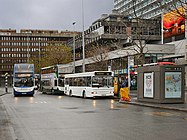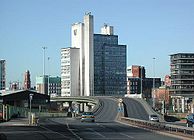Transport for Greater Manchester
 | |
 Map showing Greater Manchester, the authority's area of responsibility | |
| Abbreviation | TfGM |
|---|---|
| Predecessor | Greater Manchester Passenger Transport Executive |
| Formation | 2011 |
| Type | Public body |
| Purpose | Transport authority |
| Headquarters | Manchester |
| Location | |
Region served | Greater Manchester parts of Derbyshire, Cheshire & Lancashire |
Commissioner | Vacant |
Parent organisation | Greater Manchester Combined Authority |
Budget | £280 million (2015–16, excluding capital expenditure) |
| Website | www |
Transport for Greater Manchester (TfGM) is the public body responsible for co-ordinating transport services throughout Greater Manchester in North West England. TfGM is responsible for investments in improving transport services and facilities. It is an executive arm of the Greater Manchester Combined Authority (GMCA), the city region's administrative authority.
The strategies and policies of TfGM are set by the GMCA and its Greater Manchester Transport Committee (GMTC). The committee is made up of 33 councillors appointed from the ten Greater Manchester districts (Bolton, Bury, Manchester, Oldham, Rochdale, Salford, Stockport, Tameside, Trafford and Wigan).
History
The organisation traces its origins to the Transport Act 1968, when the SELNEC (South East Lancashire/North East Cheshire) Passenger Transport Executive was established to co-ordinate public transport in and around Manchester. Between 1974 and 2011, it was known as the Greater Manchester Passenger Transport Executive (GMPTE), until a reform of local government in Greater Manchester granted it more powers and prompted a corporate rebranding.[1]
Services

Manchester Metrolink
The Manchester Metrolink light rail system launched in 1992. Entirely subsidised by TfGM without a government grant and operated by KeolisAmey.[2] It carries over 43.7 million passengers a year.[3] With 99 stations, it is the second largest local transport network in the United Kingdom after the London Underground. Further expansion to Stockport is envisaged.
- Altrincham-Bury line
- Altrincham-Piccadilly line
- Bury-Piccadilly line
- East Didsbury-Rochdale line
- Eccles- Ashton line
- Manchester Airport-Victoria line
- MediaCity- Ashton line
- Crumpsall -Trafford Park Line
Rail services
Rail services are operated by Avanti West Coast, CrossCountry, East Midlands Railway, Northern, TransPennine Express and Transport for Wales.[4] TfGM subsidise fares on certain local services and fund station refurbishments on an ad hoc basis.
Buses
- Free Bus and Metroshuttle: launched in 2002, offering free bus services around Manchester city centre. New services were provided in Bolton, Oldham and Stockport after success of the service in Manchester.[5]
- Bus services operated by private operators including Arriva North West, Bullocks Coaches, D&G Bus, Diamond Bus North West, First Greater Manchester, First West Yorkshire, Go North West, Rosso, Stagecoach Manchester and Vision Bus.[6] From 2023 these will be merged into the Greater Manchester-wide "Bee Network".[7]
- Maintenance of bus shelters and stations, including Shudehill Interchange.
- Ring & Ride – An accessible, low-cost minibus service for people who have difficulty in using public transport.
Highways and cycling
- Greater Manchester Urban Traffic Control Unit (GMUTC) – responsibility for road management transferred to TfGM in 2009. Entails installation, maintenance and management of traffic signals, limited areas of road safety (2012), incident response and event management via a traffic control centre.
- Cycling – promotion of the Greater Manchester Cycling Strategy and delivery of Cycle Hubs and regional cycle routes.
Fares, ticketing and information
- Subsidised fares on certain services
- System One travelcards
- Get me there
- Public transport maps and timetables
- Website
- Route Explorer application
-
TfGM owns Greater Manchester's light rail system, which includes over 64 miles of track and 99 stops across seven of the ten Greater Manchester boroughs. -
Commuter rail services
Commuter rail services are provided by train operating companies (TOCs). TfGM subsidises local rail services and helps to fund station improvements across Greater Manchester. -
Bus services
Bus services in Greater Manchester are deregulated. TfGM owns and maintains bus stations, stops & shelters. It implements the System One multi-operator and multi-modal travelcards, and subsidises some fares. -
Road management
TfGM is responsible for managing the Key Route Network of major roads, as well as maintenance of traffic signals.
Bee Network
The Bee Network is a proposed integrated transport network for Greater Manchester, composed of bus, tram, cycling, and walking routes. TfGM's vision is for the network to be operational by 2024, with commuter rail services joining the network by 2030.[8]
Originally devised in 2018 as a network of active travel routes,[9] the vision for the Bee Network was expanded following the Greater Manchester Combined Authority's decision to use the powers given to it under the Bus Services Act 2017 to introduce a bus franchising scheme for the city region.[10] The active travel subset of the Bee Network was then renamed the Bee Active Network.[11]
In September 2022, TfGM ordered 50 Alexander Dennis Enviro400EV battery electric buses for use on franchised Bee Network bus services from September 2023, which will be based at depots in Wigan and Bolton. These buses are to be delivered in an all-over yellow livery, prominently featuring the Manchester worker bee. 300 more zero-emissions buses are to be delivered for service in Greater Manchester from 2024 to 2027.[12]
Transport for Greater Manchester Committee (TfGMC)
TfGM inherited the responsibilities of the Greater Manchester Passenger Transport Executive (GMPTE), which was established in 1974.
On 1 April 2011, the GMPTE became TfGM,[13] a new regional transport body for Greater Manchester[14][15][16] that forms part of the new Greater Manchester Combined Authority (GMCA). As a result, GMITA was abolished,[13] replaced by the Transport for Greater Manchester Committee (TfGMC) which ultimately reports to the Combined Authority. TfGMC and its subcommittees are made up of a nominated pool of 33 councillors from the ten metropolitan boroughs of Greater Manchester who manage TfGM and create transport policy in Greater Manchester.
Although it differs in certain structural forms,[17] on the day of its inauguration TfGM became the second most powerful and influential transport organisation in England after Transport for London, as it united previously splintered governance over transport policy in the boroughs under one body.[18][19]
It elects its own Chair and Vice-Chair and assumes the functions previously performed by GMITA, as well as the newly devolved transport powers and responsibilities from government and the ten metropolitan councils which make up the area. The 33 councillors have voting rights on most transport issues, despite not being members of the GMCA: major decisions still require approval by the GMCA, but the functions that are referred (but not delegated) to the TfGMC include making recommendations in relation to:
- The budget and transport levy
- Borrowing limit
- Major and strategic transport policies
- The local transport plan
- Operation of Greater Manchester Transport Fund and approval of new schemes
- Appointment of Director General/Chief Executive of TfGM
Corporate identity

TfGM uses a corporate identity designed in-house. The black and white "M" logo is adapted from the GMPTE logo and is used on bus stops across Greater Manchester.
Legal case
A High Court case decided in 2012 between Thales Group's transport and security subsidiary (supplier of the tram management system) [20] and TfGM considered the operation of an audit clause in a contract, and the extent to which a supplier must comply with this.[21]
See also
References
- ^ All change: Greater Manchester Passenger Transport Executive becomes Transport for Greater Manchester – with a new logo of course Archived 4 April 2011 at the Wayback Machine Manchester Evening News 1 April 2011
- ^ RATP buys Manchester Metrolink operator Railway Gazette International 2 August 2011
- ^ Light Rail and Tram Statistics: England 2018/19 Department for Transport (Retrieved 26 July 2020)
- ^ Operators Transport for Greater Manchester
- ^ Metroshuttle Archived 2 November 2012 at the Wayback Machine Transport for Greater Manchester
- ^ Bus Operators Transport for Greater Manchester
- ^ Pidd, Helen (14 March 2022). "Andy Burnham to cap Greater Manchester bus fares at £2 a journey". The Guardian. Retrieved 14 March 2022.
- ^ "Destination: Bee Network". Transport for Greater Manchester. Retrieved 24 April 2022.
- ^ "Bee Network - Greater Manchester's cycling and walking infrastructure proposal" (PDF). Retrieved 24 April 2022.
- ^ Fifield, Jack (14 February 2022). "WATCH: What is the Bee Network?". Retrieved 24 April 2022.
- ^ "MCF Financial Approvals and Active Travel Funding Additions" (PDF). 27 May 2022. Retrieved 28 May 2022.
The fund is being used to deliver the first phase of the Bee Active Network, which is the walking and cycling element of the wider Bee Network
- ^ "TfGM orders 50 Enviro400EVs for Bee Network". routeone. 22 September 2022. Retrieved 22 September 2022.
- ^ a b "Arrangements for Establishing the Combined Authority" (PDF). Association of Greater Manchester Authorities (AGMA). p. 4. Retrieved 8 February 2011.
- ^ "Draft LTP3 Consultation Proposals". Greater Manchester Integrated Transport Authority (GMITA). p. 9. Retrieved 3 December 2010.
- ^ "City Region Pilot and Governance" (PDF). Manchester City Council. p. 14. Retrieved 3 December 2010.
- ^ "Greater Manchester Local Enterprise Partnership – A Proposal To Government" (PDF). Association of Greater Manchester Authorities (AGMA). p. 18. Retrieved 3 December 2010.
- ^ "City Region Pilot and Governance" (PDF). Manchester City Council. Retrieved 3 December 2010.
- ^ "City Region Governance – Consultation on Future Arrangements for Greater Manchester" (PDF). Wigan Metropolitan Borough Council. Archived from the original (PDF) on 7 March 2012. Retrieved 3 December 2010.
- ^ "Review of City Region Governance in Greater Manchester" (Word). Bolton Metropolitan Borough Council. Retrieved 3 December 2010.
- ^ Thales Group, Thales in the North, accessed 8 May 2022
- ^ Fenwick Elliott, Dispatch, Issue 152 February 2013, accessed 8 May 2022
External links
 Media related to SELNEC at Wikimedia Commons
Media related to SELNEC at Wikimedia Commons Media related to Transport for Greater Manchester at Wikimedia Commons
Media related to Transport for Greater Manchester at Wikimedia Commons- Official website of Transport for Greater Manchester
- Greater Manchester Integrated Transport Authority
- Greater Manchester Transportation Unit
- SELNEC plans for urban rapid transport
- Greater Manchester Congestion Charge Proposals
- The SELNEC Preservation Society






